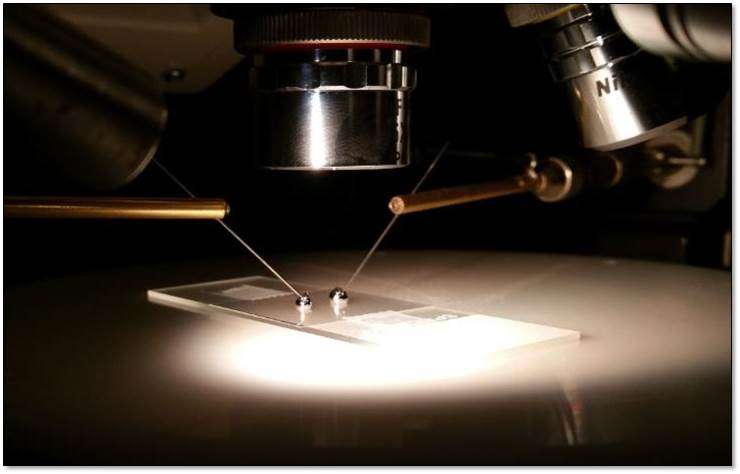Researchers develop more efficient, reliable means of electrically contacting graphene

Researchers from the Space and Naval Warfare Systems Center Pacific (SSC Pacific) devised a new way to electrically contact graphene with liquid metals rather than typical rigid electrodes such as gold and silver. Using this new method, the team demonstrated low-contact resistance with a graphene material that is comparable to the best examples published in scientific literature, but with added advantages such as flexibility and low cost.
This development, along with groundbreaking research on graphene and multi-spectral detection, earned the team of five researchers the 2016 Federal Laboratory Consortium (FLC) Far West Regional Award in the category of Outstanding Technology Development. SSC Pacific is the naval research and development lab tasked with ensuring Information Warfare superiority.
Since its discovery in 2004, graphene has been regarded as the material of the future due to its unique and desirable properties—lightweight, flexible, and an excellent conductor of electricity. Graphene's single layer of carbon atoms is a million times thinner than paper, and yet the strongest known material for its size.
Graphene is produced by a process called chemical vapor deposition (CVD). Typically, graphene is grown on copper material during the CVD process, and then the graphene-copper sample is transferred on a desired substrate where the copper is etched away. This etching process requires harsh chemicals, and often leads to contamination of the graphene, rendering it unusable. SSC Pacific's new procedure utilizes a cleaner electrolysis transfer method that gently separates the graphene from copper through electrically induced bubbles in a water bath.
SSC Pacific team members, in collaboration with the University of Hawaii's College of Engineering, take this pristine graphene and use galinstan (a non-toxic liquid metal) to fabricate clean, reliable electrical contacts. Due to liquid metal's ability to conform to surfaces, it forms better electrical contact with solid materials that lead to only nominal degrees of surface roughness. The use of liquid metal allows SSC Pacific researchers to rapidly fabricate prototype devices, which allows them to focus on the new phenomena.
Liquid-metal electrodes not only make graphene-based sensor production more efficient, the electrodes' flexible characteristics significantly expand the potential applications of the material as well.
"This is special because it enables us to explore applications into flexible devices," said Richard Ordonez, an SSC Pacific team member. "For the warfighter, that means a flexible, transparent and optical material."
The FLC award also recognized the group's groundbreaking research on graphene and multi-spectral detection; the researchers have proven—for the first time—that graphene can be combined with integrated circuits to detect electro-magnetic signals, which means there is the potential for graphene-based products that are able to switch among visible, infrared, and radio frequency modes.
Take, for example, the night vision goggles the graphene team is working to develop. Instead of the bulky version that exists today, which has poor peripheral vision and limited infrared capability, the goggles of the future would be made of graphene. They would be lightweight, conform to the user's face for a full range of vision, and be tunable to work in a variety of spectrums.
Other naval applications of the technology could include next-generation sensors, reconfigurable antennas, and lightweight clothing and gear, including camouflage material to actively cancel incoming signals. There are also many opportunities for commercial uses of the material, particularly in the wearables market.
Team members honored with the award include Nick Kamin, Dr. James Adleman, Cody Hayashi, Richard Ordonez, and Dr. Carlos Torres.
More detailed descriptions of the scientific advancements behind the award can be found in a paper published in IEEE Transactions on Electron Devices.
Additional SSC Pacific graphene research on the dual-mode operation of 2D material-base hot electron transistors was recently published in Nature's Scientific Reports.
More information: Richard C. Ordonez et al. Conformal Liquid-Metal Electrodes for Flexible Graphene Device Interconnects, IEEE Transactions on Electron Devices (2016). DOI: 10.1109/TED.2016.2599879
Yann-Wen Lan et al. Dual-mode operation of 2D material-base hot electron transistors, Scientific Reports (2016). DOI: 10.1038/srep32503
Journal information: Scientific Reports
Provided by Space and Naval Warfare Systems Center


















